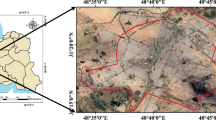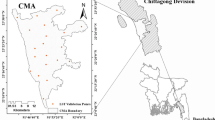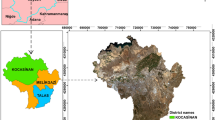Abstract
Urban heat island (UHI) effect has a close relation to land covers type. This paper investigates the relationship between land cover ratio and UHI in Guangzhou, south of China using remote sensing and automatic weather stations data. The temperature data were obtained by Automatic weather stations (AWS) of Guangzhou in October, 2004, at the same time with the CBERS remote sensing image acquired. Firstly, the hourly mean temperature was computed from hourly AWS data. Secondly, the CBERS remote sensing image was classified using support vector machine (SVM) and land covers classification were output. Thirdly, the classification result was overlapped with a round buffer with 1.5 KM radius centered on the AWS, and then the land cover ratio, Edge Density (ED) and Mean Fractal Dimension (MFRACT) of buffers were computed out. Finally, the correlation coefficient between hourly mean temperature and land cover ratio, ED and MFRACT was calculated. It concluded that UHI intensity was heavier during nighttime than daytime. Stations with higher vegetation ratio and higher ED had lower heat island effect. On the contrary, stations with higher impervious ratio and lower ED had more serious heat island effect. The positive–negative of correlation coefficient between hourly mean temperature and vegetation ratio during 11:00–17:00 h (local time) was opposite to that during other time. ED was negatively correlated with hourly mean temperature except during 11:00–17:00 h. On the contrary, MFRACT was positively correlated with hourly mean temperature. It implied that fragmentations of patches were favorable to UHI alleviation, and complexities of patch were unfavorable factors.








Similar content being viewed by others
References
Agarwal, M., & Tandon, A. (2010). Modeling of the urban heat island in the form of mesoscale wind and of its effect on air pollution dispersal. Applied Mathematical Modelling, 34(9), 2520–2530.
Ahmad, S., & Hashim, N. M. (2007). Effects of soil moisture on urban heat island occurrences: case of Selangor, Malaysia. Humanity & Social Sciences Journal, 2(2), 132–138.
Blazejczyk, K., Bakowska, M., & Wieclaw, M. (2006). Urban heat island in large and small cities. 6th International Conference on Urban Climate, Göteborg, Sweden, 794–797.
Brown, M., Gunn, S. R., & Lewis, H. G. (1999). Support vector machines for optimal classification and spectral unmixing. Ecological Modelling, 120(2–3), 167–179.
Bruzzone, L., Chi, M. M., & Marconcini, M. (2006). A novel transductive SVM for semisupervised classification of remote-sensing images. IEEE Transactions on Geoscience and Remote Sensing, 44(11), 3363–3373.
Chen, X. L., Zhao, H. M., Li, P. X., & Yin, Z. Y. (2006). Remote sensing image-based analysis of the relationship between urban heat island and land use/cover changes. Remote Sensing of Environment, 104(2), 133–146.
Dousset, B., & Gourmelon, F. (2003). Satellite multi-sensor data analysis of urban surface temperatures and landcover. ISPRS Journal of Photogrammetry and Remote Sensing, 58(1), 43–54.
Fabrizi, R., Bonafoni, S., & Biondi, R. (2010). Satellite and ground-based sensors for the urban heat island analysis in the city of Rome. Remote Sensing, 2, 1400–1415.
Gallo, K. P., & Tarpley, J. D. (1996). The comparison of vegetation index and surface temperature composites for urban heat-island analysis. International Journal of Remote Sensing, 17(15), 3071–3076.
Gedzelman, S. D., Austin, S., Cermak, R., Stefano, N., Partridge, S., Quesenberry, S., et al. (2003). Mesoscale aspects of the urban heat island around New York City. Theoretical and Applied Climatology, 75(1–2), 29–42.
Gluch, R. (2002). Using high spatial resolution airborne thermal-IR data to map the urban thermal environment. IEEE Geoscience and Remote Sensing Symposium, 3, 1923–1925.
Howard, L. (1833). The climate of London, deduced from meteorological observations.
Hung, T., Uchihama, D., Ochi, S., & Yasuoka, Y. (2006). Assessment with satellite data of the urban heat island effects in Asian mega cities. International Journal of Applied Earth Observation and Geoinformation, 8(1), 34–48.
Imhoff, M. L., Zhang, P., Wolfe, R. E., & Bounoua, L. (2010). Remote sensing of the urban heat island effect across biomes in the continental USA. Remote Sensing of Environment, 114(3), 504–513.
Khaikine, M. N., Kuznetsova, I. N., Kadygrov, E. N., & Miller, E. A. (2006). Investigation of temporal-spatial parameters of an urban heat island on the basis of passive microwave remote sensing. Theoretical and Applied Climatology, 84(1), 161–169.
Marina, S., & Constantinos, C. (2007). Study of the urban heat island of Athens, Greece during daytime and night-time. Urban Remote Sensing Joint Event, 1–7. http://ieeexplore.ieee.org/xpl/freeabs_all.jsp?arnumber=4234401.
Matson, M., McClain, E. P., McGinnis, D. F., Jr., & Pritchard, J. A. (1978). Satellite detection of urban heat islands. Monthly Weather Review, 106(12), 1725–1734.
McGarigal, K., Cushman, S. A., Neel, M. C., & Ene, E. (2002). FRAGSTATS: Spatial pattern analysis program for categorical maps. Amherst: University of Massachusetts.
Mirzaei, P. A., & Haghighat, F. (2010). Approaches to study urban heat island—abilities and limitations. Building and Environment, 45(10), 2192–2201.
Nichol, J. (2005). Remote sensing of urban heat islands by day and night. Photogrammetric Engineering and Remote Sensing, 71(5), 613–621.
Oke, T. R. (1982). The energetic basis of the urban heat-island. Quarterly Journal of the Royal Meteorological Society, 108(455), 1–24.
Oke, T. R. (1987). Boundary layer climates. USA: Methuen.
Owen, T. W., Carlson, T. N., & Gillies, R. R. (1998). An assessment of satellite remotely-sensed land cover parameters in quantitatively describing the climatic effect of urbanization. International Journal of Remote Sensing, 19(9), 1663–1681.
Pal, M., & Mather, P. M. (2005). Support vector machines for classification in remote sensing. International Journal of Remote Sensing, 26(5), 1007–1011.
Rao, P. K. (1972). Remote sensing of urban heat islands from an environmental satellite. Bulletin of the American Meteorological Society, 53, 647–648.
Roth, M., Oke, T. R., & Emery, W. J. (1989). Satellite-derived urban heat islands from three coastal cities and the utilization of such data in urban climatology. International Journal of Remote Sensing, 10(11), 1699–1720.
Sarrat, C., Lemonsu, A., Masson, V., & Guedalia, D. (2006). Impact of urban heat island on regional atmospheric pollution. Atmospheric Environment, 40(10), 1743–1758.
Shepherd, J. M. (2006). Evidence of urban-induced precipitation variability in arid climate regimes. Journal of Arid Environments, 67(4), 607–628.
Stathopoulou, M., & Cartalis, C. (2009). Downscaling AVHRR land surface temperatures for improved surface urban heat island intensity estimation. Remote Sensing of Environment, 113(12), 2592–2605.
Streutker, D. R. (2003). Satellite-measured growth of the urban heat island of Houston, Texas. Remote Sensing of Environment, 85(3), 282–289.
Su, L., Chopping, M. J., Rango, A., Martonchik, J. V., & Peters, D. P. C. (2007). Support vector machines for recognition of semi-arid vegetation types using MISR multi-angle imagery. Remote Sensing of Environment, 107(1–2), 299–311.
Taha, H. (1997). Urban climates and heat islands: Albedo, evapotranspiration, and anthropogenic heat. Energy and Buildings, 25(2), 99–103.
Taha, H., Akbari, H., & Rosenfeld, A. (1991). Heat-island and oasis effects of vegetative canopies—micro-meteorological field-measurements. Theoretical and Applied Climatology, 44(2), 123–138.
Todhunter, P. E. (1996). Environmental indices for the Twin Cities Metropolitan Area (Minnesota, USA) urban heat island—1989. Climate Research, 6(1), 59–69.
Tong, H., Walton, A., Sang, J., & Chan, J. C. L. (2005). Numerical simulation of the urban boundary layer over the complex terrain of Hong Kong. Atmospheric Environment, 39(19), 3549–3563.
Uuemaa, E., Antrop, M., Roosaare, J., Marja, R., & Mander, Ü. (2009). Landscape metrics and indices: an overview of their use in landscape research. Living Reviews in Landscape Research, 3(1).
Weng, Q., Liu, H., & Lu, D. (2007). Assessing the effects of land use and land cover patterns on thermal conditions using landscape metrics in city of Indianapolis, United States. Urban Ecosystems, 10(2), 203–219.
Yuan, F., & Bauer, M. E. (2007). Comparison of impervious surface area and normalized difference vegetation index as indicators of surface urban heat island effects in Landsat imagery. Remote Sensing of Environment, 106(3), 375–386.
Zhang, P., Imhoff, M. L., Wolfe, R. E., & Bounoua, L. (2009). Characterizing urban heat island effect at global settlements using MODIS and nightlight products. American Geophysical Union, Fall Meeting, U33B–U0054B. http://adsabs.harvard.edu//abs/2009AGUFM.U33B0054Z.
Acknowledgment
The authors are grateful to anonymous reviewers for their valuable comments and suggestions that greatly improve the presentation of this paper. This study was jointly supported by the NSFC of Yunnan province, China (KKSA200921019), Scientific Research Foundation of Kunming University of Science and Technology (KKZ3200821048) and the innovation team of ore-forming dynamics and prediction of concealed deposits, Kunming University of Science and Technology, Kunming, China (2008).
Author information
Authors and Affiliations
Corresponding author
About this article
Cite this article
Wen, X., Yang, X. & Hu, G. Relationship Between Land Cover Ratio and Urban Heat Island from Remote Sensing and Automatic Weather Stations Data. J Indian Soc Remote Sens 39, 193–201 (2011). https://doi.org/10.1007/s12524-011-0076-4
Received:
Accepted:
Published:
Issue Date:
DOI: https://doi.org/10.1007/s12524-011-0076-4




